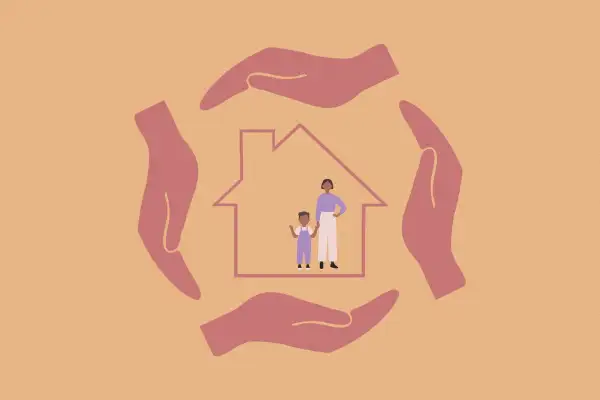Mortgage Life Insurance vs. Traditional Life Insurance: What's Best for Your Family?

Paying off a mortgage after your death is among the reasons to get life insurance. But there’s another policy type that covers you only for your mortgage debt, and it’s a useful alternative for some homeowners.
In the event you die before you’ve paid off your house, mortgage life insurance (also known as mortgage protection insurance) takes care of any remaining balance on that loan. It shouldn’t be confused with the private mortgage insurance that’s required for homeowners who make a downpayment of less than 20% of the loan amount. That insurance protects your lender, where mortgage life insurance protects your heirs from inheriting your mortgage debt.
“Mortgage life insurance is similar to traditional life insurance, but the benefits don’t go to beneficiaries,” explains Marina Vaamonde, commercial real estate investor and founder of PropertyCashin. “Instead, the coverage goes fully to the payment of the remaining mortgage.”
Here’s what you need to know about mortgage life insurance, including more on how it compares to traditional life insurance as a way to protect your biggest asset once you’re no longer around to make payments on its mortgage.
Protecting the mortgage vs. insuring your life
Mortgage life insurance is typically purchased from leading insurance companies or directly from your mortgage lender. Not all insurance companies offer this type of coverage, according to Andrina Valdes, COO of Cornerstone Home Lending.
MLI can be purchased when you close on buying the home, or later if you wish. If you opt for earlier, you can simply ask your lender if they can fold this cost into your monthly mortgage payment. And if you’re a disabled veteran, you can check with the Veterans Administration about coverage.
The older you are, the higher the premium you’ll pay, says Valdes. MLI is not inexpensive. If you have $120,000 left on your mortgage, you may find a mortgage insurance policy with bare minimum coverage for $50 a month, according to online insurance broker insure.com. Adding riders, such as return of premium and living benefits, can increase monthly premiums to $150 or more on that same $120,000 amount.
Here’s how the insurance works. Let’s say you take out a 30-year mortgage loan for $500,000. You could cover your investment by taking out a 30-year term mortgage protection policy for the same amount, $500,000. If you died at any point in those 30 years, you’d be covered for the full loan amount. But you needn’t continue the policy if, for example, a windfall allows you to discharge the mortgage or you decide you no longer need it.
Mortgage life insurance doesn’t automatically drop away once you have paid a certain amount of the mortgage, as happens with private mortgage insurance. Private mortgage insurance isn’t forever. Once your loan reaches its halfway point, i.e., 15 years into a 30-year loan, or once your loan-to-value (LTV) reaches 80%, the coverage and premiums for private mortgage insurance stop automatically, says Valdes.
Where mortgage life insurance targets only the obligation to pay off your home loan, traditional life insurance can — and often does — address a range of financial needs that would arise for your family were you to die.
But calculations of how much life insurance a policyholder needs should certainly include any debts, such as a mortgage, that your family would struggle to manage were you to pass on before they were discharged.
So if you hold a 30-year mortgage, you might, for example, take out a 30-year term life insurance policy with a death benefit that meets or exceeds your mortgage balance. If you died within that term, your family could use the death benefit to cover mortgage payments plus other expenses.
Coverage for those additional expenses is a key distinction to life insurance. While mortgage life insurance exclusively covers mortgage payments, term life insurance can cover your remaining mortgage payments plus other expenses your beneficiaries might have, such as car loans, college expenses, day-to-day living, and additional home costs such as taxes and maintenance.
Which option is right for me?
Most often, life insurance is the better option. The reasons begin with the fact that both insurance options have steady premiums for as long as you have the policy, but only life insurance also keeps the benefit steady.
With mortgage life insurance, your stable premium payments eventually entitle you to a steadily diminishing benefit. That’s because the policy exclusively covers the outstanding mortgage balance. While that amount barely budges in the early years of the mortgage term, it drops quickly toward the end. It can take years, even decades, for the principal to drop by any amount.
“The value of mortgage life insurance decreases over time as you pay toward your principal, which should be considered when comparing quotes to life insurance,” explains Jackie Morales, Chief Insurance Officer at Bestow.
Because the benefit of MLI is tied to the mortgage balance, your family can’t benefit from any coverage that exceeds what is owed on the mortgage. That makes a term life policy the more flexible option since its death benefit can be used for any purpose.
There are instances where mortgage protection can be the better option, though. According to personal finance expert Andrea Woroch, those who may struggle to get approved for a term life insurance policy due to age or health may consider MLI, as it does not go through standard underwriting.
She adds that those who already have a life insurance policy and purchase a more expensive home while accumulating other day-to-day expenses, such as educational or rearing costs, should consider mortgage protection coverage. Your life insurance death benefit may not be enough to cover these expenses plus the new house payment.
You may also favor mortgage life insurance if you prefer that the death benefit be paid to the lender directly. “Do you trust your beneficiary to use insurance as you hope it will be? If not, mortgage life insurance can ensure your family does not lose their home or have to sell as it is paid directly to the lender,” says Woroch.
Ultimately, though, unless those special conditions apply, life insurance is the more beneficial option. “With life insurance, your family — not your lender — has a financial safety net when it’s needed most,” adds Morales. “If a life insurance policyholder passes away, their beneficiary receives a payout that provides flexibility and stability when it’s needed most.”
More from Money:
Best Life Insurance Companies of 2021
